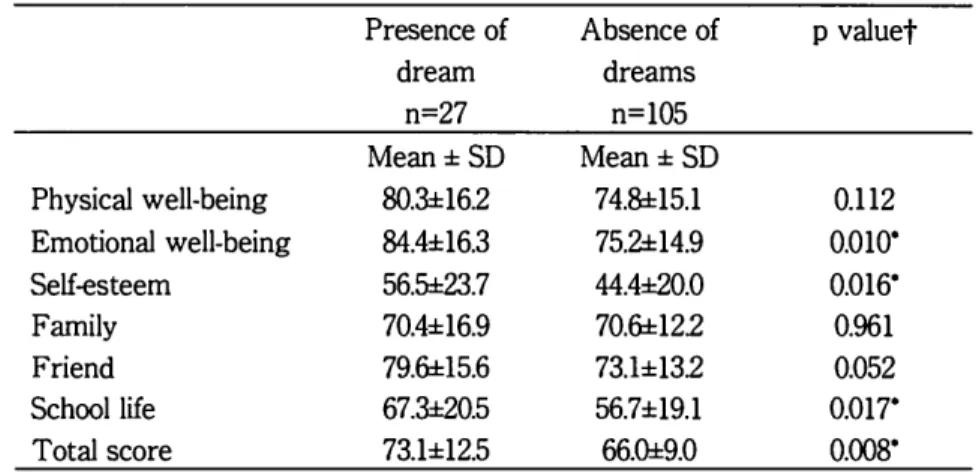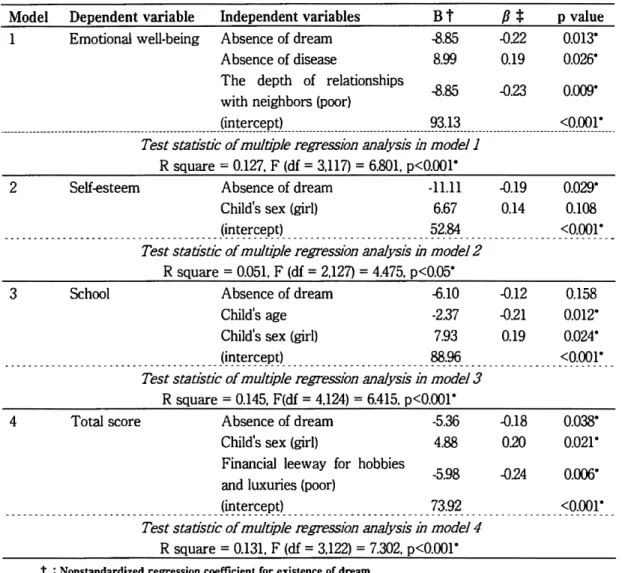The Relationship Quality of Life of Children and Internal, Family's Environment Factors : Focusing on the Presence of Dreams for the Future in Children
著者名(英) Kanami Kamide
journal or
publication title
Bulletin of the faculty of home economics Kyoritsu Women's University
volume 64
page range 157‑164
year 2018‑01
URL http://id.nii.ac.jp/1087/00003207/
~t~~O)~ya50)1( (QOL) ~:iottQf1;JIW~~t
*J@ffljji t 0) 00 31
-*1*0)~0)1ffflt,:*r 13 L, ~ -
The Relationship Quality of Life of Children and Internal, Family's Environment Factors -Focusing on the Presence of Dreams for the Future in Children-
..t lli ffi: it Kanami KAMIDE
fflX~f-J
r c:· 1b 0)~750)Ji(QOL)li, -=f c:· t
O)~~~11~u, ,i:.,~O)~x:t~ntt~f/J 'd:" 1j-
~o .:. c: t,tffl~
~n --c \., \-:,
0 ~ ':) , : ,fflO) AfUHMH,-f- ( ',/- "1/-\' )v '
;r, ·:; 1' ry- 7) ~{f.fi1Hr-1~m b Tc:· b
0)QOL ,:f.'~'d:"lj-~--) o.:. c: t,tl!ij ':)l}l,:
~n "(l.,\oo
L t,l L. -=f c:· t O):¥-t*=O)W-0)1if 1W: c: QOL c: 0) oo~,:--:J" \--c 1iwaJ1fnt~"
\0*uJf?EO) El B{J1i, -=f c:· 1h O)~ffiO)~(QOL) c: ~*=O)W-0)1if1W: c: 0) OO~'d:"aA ':)t,l,:-t o.:. c: --r-~oo ,J,~~0)9r.1i i:3 J:: rJ'-f O)ffl 'd:" Mtu:, -m
&1xlft
~i* ,: J:: o 7 :,, 'r- 1' wa11f ~ ~m!i L t.:.o 9r.ii'U:M-t o ~1fpg~
Ii, ~*=O)W-0)1if~ c: -fO)pg~J:3 J:: r.f,J,~~lt&
QOL R.tr ,: --C QOL 'd:" wal1f Lt.:. oft ,:t-t L --C Ii,
i!iJiJrft ~ ~" \~r@1~89~m,: oo-t o 7:,, 'r- "
~1l:'d:"~m!i L t.:.o 132
~0)-=fc:· t c: 99 ~O)tQ,t,\
':) O)lfil~'d:"~tt~B{J,:5tl/r L t.:.*a~L '27 ~
(20.5%)0)-=f c:· 16 t,ql*O)W,i,{~1., \ c: IHI~ L t.:.o
W-nt~ 1., \-=f c:· t liW-0)~ o -=f c:' 16 c: Jtf.Z L --c,
;fir~,: QOL ~{~.~t,t15:i1\-? t.:. (p<0.05) o
~':) ,:, QOL O)r{!l:JJi§ ,:1:31.,\--c 16, W-t,t~1.,\-=fc:' 16 liW-0) ~ o-=f c:· t c: Jt~ L --c, t1H$89flmt, El ~~·lfi, ~fX~ffiO)~hxO){~t~t,~;fif]l. ,: 15:i,l -? t.:. (p<0.05) o
~':) ,: , -=f c:' t O)~ffi#, t1~1t
~1n:0)1if~, fflO)i/i:P.Jr--:1~ ~"\~*it~B{J~mc:
\.,\-?t.:.3c~~~'d:"~U~89,:~~Lt.:*a*, ~l
*=O)W,O)
~1., \-=f c:· 1b Ii QOL ~{~ifi:3 J:: rlfflfltl
89 flmt, El ~~·lff
0)~hx {~ .~ t,t;fif iJ: 15: l}l-? t.:.
(p<0.05)o -=fc:'t>O) QOL O)[o]_tJ:li, -=fc:'16 t,t~l*=O)W-~~~t o J::--) ,:~rt L "(1.,\ <.:. c: n"
li:~1: 3; o C: ~ ~ ':) nt.:.o
I. Introduction
Quality of life (QOL) is an important aspect of human health. The development of assessment scales for QOL has progressed, and such scales have become common in healthcare research and clinical settings. In fact. QOL scales such as the world health organization quality of life assessment (WHOQOL )ll and MOS 36-item Short-Form Health survey (SF-36)
2lare gen- erally used to assess QOL in many scientific studies. On the other hand, the WHOQOL and SF-36 were developed to assess the QOL of adults. and it is not possible to evaluate the QOL of children using these scales. However, evaluating the QOL of children is an important indicator of child health.
In response, a scale specifically for assessing children's QOL has been developed
31•and a Japanese version was also created
41•Although adult's QOL is generally regarded as important and many relevant studies had been conducted.
there are relatively few studies investigating
the QOL of children
51•These include studies
investigating the factors influencing the QOL of children using a QOL scale specific to children
4.67l_These previous studies suggest that the child's age, sex, mental and physical condition
41,social network
61,and the frequency of conversations with their mother
7linfluence their QOL. Fur- thermore, the authors of this study previously investigated the relationship between envi- ronmental factors and the QOL of children
81•Our results indicated that the parent's social network and the household financial situation affect the QOL of children. Based on the results of these previous studies, various physical, psychological and social factors, as well as basic characteristics such as the age and sex of the child are suggested to influence the QOL of children. However, these factors reported in previous studies are difficult to change. In addition, regarding the mental and physical condition of children, the definition of reversi- bility is difficult except for acute status. In order to construct means of support to main- tain and improve children's QOL, it is neces- sary to clarify which factors related to the QOL of children can be changed or reversed.
On the other hand, the relationship between satisfaction with school life and the "skills necessary for daily life" has been investigated in the research field of pedagogy
91•Ito et al.
91defined the "skills necessary for daily life" as ability/skill, social adaptability, attitude/sense of value, self-growth, and satisfaction with school life and found it to be one aspect of QOL in children. They also found ability/skill and self-growth to be related to satisfaction with school life
91•Ability/skill refers to communica- tion skills, and self-growth ability refers to the presence of dreams for the future
91•In other words, it seems that communication skills and the presence of dreams for the future are as-
sociated with QOL in children. If it can be clarified that the presence of dreams for the future is associated with QOL, it may possible to contribute to the development of a simple tool to evaluate QOL in children and to con- struct means of support for maintaining and improving QOL in children. Therefore. the aim of this study was to clarify the relationship between the QOL of children and the presence of dreams for the future.
II. Methods 1. Participants
Elementary school children and their parents who lived in public housing in S City, Kana- gawa Prefecture, Japan were recruited for this study. The children and their parents who were the participants of this study were ex- tracted from the PT A list of the children's elementary school.
2. Data collection
Data were collected from self-completed questionnaires. The questionnaires were dis- tributed individually by research assistants to all participants (elementary school children and their parents), and 1 week after distribution. the research assistants visited the participants again to collect the completed questionnaires.
The research assistants were also residents of public housing in S City. Regarding the ques- tionnaires, one self-completed questionnaire was included for elementary school children and one self-completed questionnaire was in- cluded for their parents; we asked the children and parents to answer their respective ques- tionnaire.
With regard to the questionnaire form for
elementary school children. we used the J ap-
anese version of the Questionnaire for Meas-
uring Health-Related Quality of Life in Children (KINDLR)
31,which has verified reliability and validity
-1.1°1•to investigate the QOL of elemen- tary school children. This scale consists of 24 question items. and responses for each item are given on a five-point Likert scale. The Japanese version of KINDLR is divided into the following six dimensions to assess QOL: physical well-being, emotional well-being, self-esteem.
family, friends. and school. Using the responses given on the five-point Likert scale. both the total score and sub-scores of each dimension are converted from Oto 100 points, with higher score indicating a higher QOL
4.1°1•In addition.
we asked the about the child's age, sex, pres- ence or absence of disease. presence or absence of siblings, and presence or absence of dreams for the future in the questionnaire for children.
To investigate the presence or absence of dreams for the future. the following question was asked: "What is a dream you have for the future?". The answer was requested by free description. If the children answered "none" or did not respond to the question at all. we cat- egorized it as the absence of dreams. All re- sponses with the exception of "none" and no response were categorized as the presence of dreams. These categories were used in all statistical analyses.
In the questionnaire form for parents, we investigated the relationship with neighbors and the stability of household finances. Regarding the relationship with neighbors, we asked about the depth of relationships and the number of neighbors with whom they associated. Re- sponses for the depth of relationships were given on the following four-point Likert scale: 1) we cooperate with each other.
2>we talk with each other.
31we greet each other. and
41no communication at all. Regarding the stability of
household finances, we investigated whether there were concerns about unexpected ex- penses. and whether there was financial leeway for hobbies and luxuries with responses for each question given on a four-point Likert scale.
The relationship with neighbors and the household financial situation were adopted as confounding factors against QOL in accordance with a previous study
81•3. Ethics
All questionnaires were anonymous in order to keep the personal information of the par- ticipants confidential and to prevent the iden- tification of individual participants. Further. the researchers were not involved in the process of extracting participants from the PT A list. In addition, when we distributed the questionnaire forms to the participants, we explained that responding to the questionnaire was voluntary, that results of this survey would be used only for academic purposes and that returning a completed questionnaire would be taken as agreeing to participate in the study. This study was approved by the Kyoritsu Women's Uni- versity research ethics review board (approval number: KWU-IRBA #15091).
4. Statistical analysis
To investigate the relationship between children's QOL and the presence of dreams.
differences in the total score and sub-scores of the KINDLR were analyzed by the presence or absence of dreams using an unpaired t test. To determine the confounding factors for QOL, the relationship between KINDL R scores and the child's age, sex. presence of disease. presence of siblings, parents' relationship with neighbors.
and household financial situation were analyzed
using an unpaired t test or Spearman's rank
correlation coefficient. Finally, multiple regres- sion analysis adjusted for confounding factors was conducted with KINDL
Rscores as the dependent variable and the presence of dreams as the independent variable in order to de- termine the relationship between QOL and the presence of dreams. All statistical analyses were performed using the R programming language and environment (R version 32.1) rn_
The level of statistical significance was set at 5%.
Ill. Results
Valid responses were obtained from 132 elementary school children and 99 of their parents. The valid response rate was estimated at about 45% since the questionnaires were distributed to about 280 children and about 220 parents. The mean age of the children who responded to the questionnaire was 9.1±1.9 years. 56 (42.4%) were boys, 17 (12.9%) had no siblings, and 19 (14.4%) indicated presence of a disease. 27 children (20.5%) were classified as having the absence of dreams according to the
definition above.
As for the depth of parents' relationships with neighbors, the response of "we greet with each other'' was the most frequent (45 parents, 45.5%), and less than four was the most fre- quent response for the number of people with whom they associated (47 parents, 47.5%). Re- garding the household financial situation, 94 parents (94.9%) answered that they had con- cerns about unexpected expenses, and 37 parents (37.3%) had some financial leeway for hobbies and luxuries.
The total KINDL
Rscore in children was 71.6±12.2 points, and the score of each of the six dimensions were as follows: physical well-being was 79.2±16.1 points. emotional well-being was 82.6±16.4 points, self-esteem was 54.1±23.4 points, family was 70.5±16.0 points, friends was 78.3±15.3 points, and school was 65.1±20.6 points.
The total score and the scores for emotional well-being, self-esteem, and school were sig- nificantly higher in children with dreams than in those without (Table 1). Based on the results of univariate analysis, the presence of dreams,
Table 1. Presence or absence of dreams for the future and KINDLR scores
Presence of dream
n=27 Mean±SD Physical well-being 80.3±16.2 Emotional well-being 84.4±16.3
Self-esteem 56.5±23.7
Family 70.4±16.9
Friend 79.6±15.6
School life 67.3±20.5
Total score 73.1±12.5
Absence of dreams
n=l05 Mean± SD
74.8±15.1 75.2±14.9 44.4±20.0 70.6±122 73.1±132 56.7±19.1 66.0±9.0
p valuet
0.112 0.010·
0.016·
0.961 0.052 0.011·
0.008·
t:
Comparison of KINDLR scores between presence of dream and absence of dream. Comparison was per- formed using unpaired t test·: The level of statistical significance was less than 5 percent

